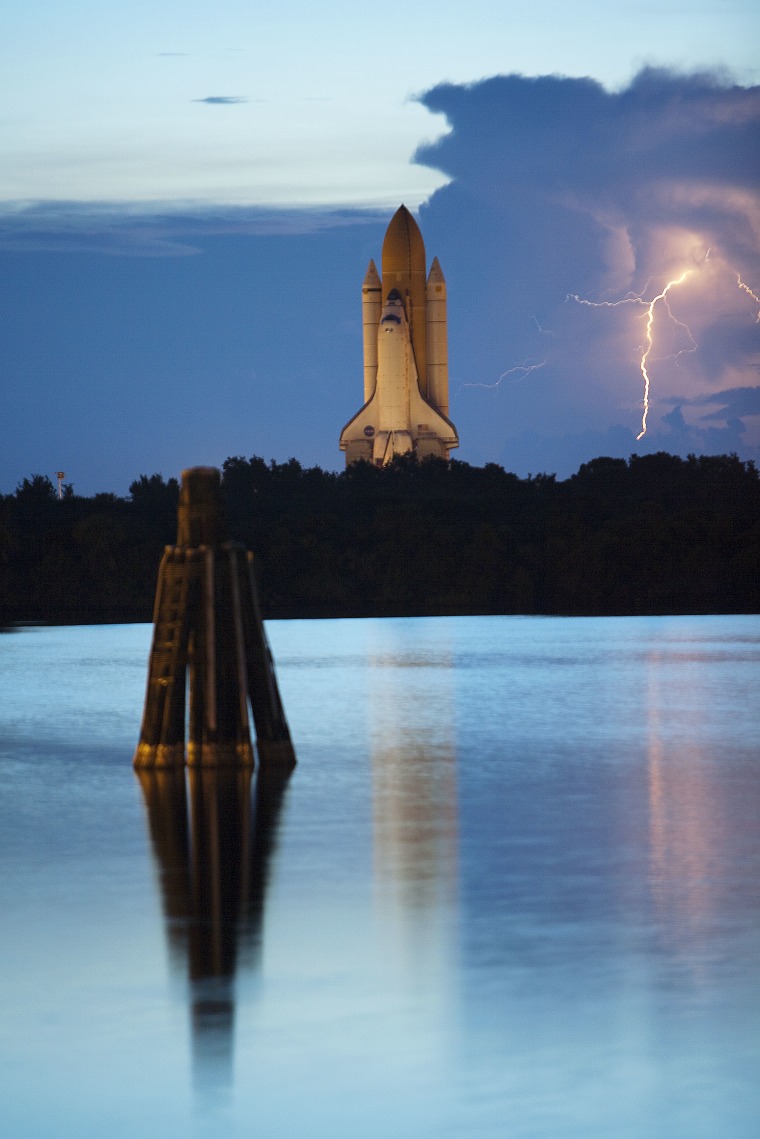The space shuttle Discovery rolled out to its Florida launch pad Tuesday in an arduous, slow trek made even slower by brilliant lightning flashes and soggy mud.
Engineers began moving Discovery out to the seaside Pad 39A at NASA's Kennedy Space Center before dawn Tuesday to begin priming the shuttle for its planned Aug. 25 launch toward the International Space Station. Distant lightning lit up the sky above the Cape Canaveral spaceport, providing a stunning backdrop for the shuttle's plodding move.
The trip normally takes about six hours, but weather-related concerns pushed Discovery's slow move beyond the 11-hour mark.
Stormy, soggy weather
NASA initially delayed Discovery's trip by nearly two hours in order to keep shuttle technicians inside and safe from potential lightning strikes at the launch site. By 2:07 a.m. EDT (0607 GMT), it was safe to begin moving Discovery but sticky mud from recent thunderstorms forced engineers to stop repeatedly to clean the giant treads of NASA's 5.5 million-pound (2.4 million-kg) Apollo-era crawler carrier vehicle that hauls shuttles out to the launch pad.
"We had torrential rain here yesterday evening," NASA spokesperson Allard Beutel told SPACE.com from the spaceport. "It rained for hours ... so it was pretty soggy."
Despite the lightning and mud delays, shuttle technicians were more concerned about moving Discovery to the launch pad ahead of stormy weather that was expected to hit the spaceport Tuesday afternoon.
A tall lightning mast and shell-like protective structure at the launch pad can guard shuttles against lightning and stormy weather, but the spacecraft and their support crews are exposed to the elements when they make the short 3.2-mile (5-km) trek from NASA's massive Vehicle Assembly Building and Pad 39A.
Bolts of lightning struck 11 times near the shuttle launch pad last month, causing one of a series of delays for Discovery's sister ship Endeavour. That shuttle ultimately launched to the International Space Station on July 15 and landed July 31.
COLBERT aims for space
Commanded by veteran astronaut Rick Sturckow, Discovery is slated to fly a 13-day mission to replace one member of the space station's six-person crew and deliver new supplies and experiments. Three spacewalks are planned to upgrade the station's cooling system and European Columbus laboratory.
The shuttle will also deliver the station's new COLBERT treadmill, which is named after comedian Stephen Colbert, when it arrives at the space station.
Sturckow and his crew will arrive at the Kennedy Space Center Wednesday to begin a three-day training session that will end with a launch dress rehearsal and shuttle escape drill on Friday. Meanwhile, shuttle engineers plan to replace a faulty valve on Discovery's left solid rocket booster over the next week.
"We have no margin, no cushion, in the schedule at all," said Beutel, adding that there is a possibility Discovery may be ready to fly on Aug. 24.
NASA has until Aug. 30 to launch Discovery before it would stand down to late September due to a conflict with a new Japanese cargo ship test. Japan's first H-2 Transfer Vehicle, an unmanned space freighter, is slated to begin its maiden flight to the space station on Sept. 10.
